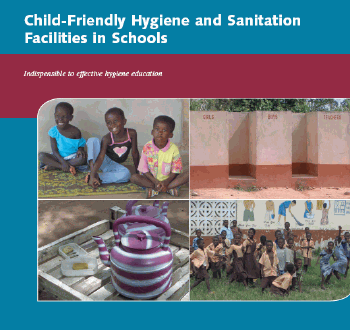Child-Friendly Hygiene and Sanitation Facilities in Schools
 |
Indispensible to effective hygiene education
livre coll. Technical Paper Series n° 44 Jan 2005 ; 46 pages
Aut. Annemarieke Mooijman & Jaap Zomerplaag
Ed. IRC - Den Haag ; Isbn: 90-6687-050-8
Téléchargeable chez l'éditeur
Page de présentation d'un éditeur
Abstract:
This document covers all the stages of a design project, from needs assessment to operation and maintenance, because effective child-friendly hygiene and sanitation facilities cannot be realised merely by improving designs. It stresses the importance of active involvement of children, teachers, parents and the community during all of these stages so that they themselves will be able to find solutions for their own problems and needs.
The scope of this document is limited to the design of the ‘space’ containing the hygiene and sanitation facilities. It does not describe the different technical options for sanitation or the different methodologies for hygiene education. Within the context of this booklet the provision of water is addressed insofar as it is required to enable hygienic behaviour, e.g. to flush and clean sanitation facilities and for hand washing. Although considered essential, the provision of safe drinking water in schools has only marginally been addressed. The word ‘toilet’ is used for all kinds of technical sanitation solutions, i.e. flush toilets, pour flush toilets, VIP latrines, simple pit latrines, etc. Reference is made to a ‘latrine’ when the point addressed specifically reflects problems and solutions related to pits.
The document describes in ten points those issues that are important when dealing with children, hygiene and sanitation in the school environment and provides practical, easily accessible guidance to policy makers, programme designers and implementers at field level. The ideas presented should not be considered as blueprints for solutions. Rather, they are ‘concepts’ intended to stimulate discussions and creative thinking and that will need to be tailored to a particular project context. Moreover, they can serve for both the construction of new facilities and the rehabilitation of existing ones. The booklet contains two annexes showing how to integrate the different concepts: a checklist and a ‘sample set-up’ for the implementation of hygiene and sanitation facilities in schools. Contents:
Ten points towards child-friendly hygiene and sanitation facilities in schools
Child-friendly hygiene and sanitation facilities in schools:
1. Are 'interactive' spaces that stimulate children's learning and development.
2. Are designed with involvement of children, teachers, parents and communities.
3. Provide lowest-cost solutions with no compromise on quality.
4. Have operation and maintenance plans.
5. Have appropriate dimensions and features for children.
6. Address the special gender-related needs and roles.
7. Do not harm the environment.
8. Encourage hygienic behaviour.
9. Offer enough capacity and minimal waiting time.
10. Choose well considered locations.
References
Annex 1 Checklist child-friendly facilities
Annex 2 Sample set-up for the development of hygiene and sanitation facilities
Publics-Cibles:
Mots clefs: |
assainissement (CI) (DT) (OP) (ope) , école (CI) (DT) (OP) (ope) , hygiène (CI) (DT) (OP) (ope) |
Editeur/Diffuseur: |
|
IRC - Den Haag - Pays Bas |
En cas de lien brisé, nous le mentionner à communication@pseau.org